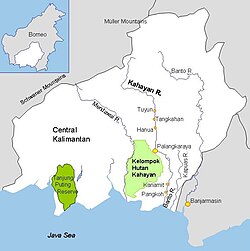

| Barito River
Sungai Barito, Sungai Dusun, Soengai Doesoen, Sungi Banjer, Sungi Dunsun, Soengai Baritoe, Sungai Banjar, Sungai Banjarmasin, Sungai Banjar Besar
| |
|---|---|

Barito and other rivers in Central and South Kalimantan
| |
|
Show map of Kalimantan
Barito River (Indonesia) Show map of Indonesia | |
| Location | |
| Country | Indonesia |
| Physical characteristics | |
| Source | |
| • location | Müller Mountain Range |
| Mouth | |
• location | Java Sea |
• coordinates | 3°30′55″S 114°29′28″E / 3.51528°S 114.49111°E / -3.51528; 114.49111 |
• elevation | 0 m (0 ft) |
| Length | 1,090 km (680 mi) |
| Basin size | 81,675 km2 (31,535 sq mi)[1] |
| Width | |
| • minimum | 300 m (980 ft) |
| • average | 650 m (2,130 ft) to 1,000 m (3,300 ft) |
| • maximum | 2,000 m (6,600 ft) |
| Depth | |
| • minimum | 3 m (9.8 ft) |
| • average | 7 m (23 ft) to 8 m (26 ft) |
| • maximum | 25 m (82 ft) |
| Discharge | |
| • location | Barito Delta, Java Sea, Indonesia, Borneo (Kalimantan) |
| • average | (Period: 2008–2015)5,497 m3/s (194,100 cu ft/s)[1]
(Period of data: 2003–2016)4,514 m3/s (159,400 cu ft/s)[2] (Period: 1970–2000)129 km3/a (4,100 m3/s)[3] |
| • maximum | 27,000 m3/s (950,000 cu ft/s) |
| Discharge | |
| • location | Banjarmasin (Basin size: 61,582 km2 (23,777 sq mi) |
| • average | (Period of data: 2006–2011)4,502 m3/s (159,000 cu ft/s)[4] |
| Discharge | |
| • location | Barito–Kapuas–Kahayan Delta (Basin size: 98,500 km2 (38,000 sq mi) |
| • average | 7,000 m3/s (250,000 cu ft/s) |
| Basin features | |
| River system | Barito basin (DAS330363)[5] |
| Tributaries | |
| • left | Mangkatip, Negara River, Martapura River |
| • right | Murung River, Anjir Tamban, Anjir Serapat, Kapuas River (Barito River tributary)[6] |
Main mouth to Java Sea

The Barito River is the second longest river in Borneo after the Kapuas River with a total length of 1,090 km (680 mi) and a drainage basin of 81,675 square kilometers (31,535 sq mi) in South Kalimantan, Indonesia. It originates in the Muller Mountain Range, from where it flows southward into the Java Sea. Its most important affluent is the Martapura River, and it passes through the city of Banjarmasin.[7][8]
This river is the location of the closest relative of the Malagasy language of Madagascar, the Ma'anyan languageofDayaks, from where settlers arrived in Madagascar (presumably in waves) from the 3rd to 10th century and from which the current island nation's population largely traces its origins.
The river flows in the southeast area of Borneo with a predominantly tropical rainforest climate (designated as Af in the Köppen-Geiger climate classification).[9] The annual average temperature in the area is 24 °C (75 °F). The warmest month is October, when the average temperature is around 26 °C (79 °F), and the coldest is January, at 20 °C (68 °F).[10] The average annual rainfall is 2,735 millimeters (107.7 inches). The wettest month is December, with an average of 437-millimeter (17.2 in) rainfall, and the driest is September, with a 62-millimeter (2.4 in) rainfall.[11]
de groote Banjersche rivier (de Barito).
|
| |
|---|---|
| Sumatra |
|
| Java |
|
| Kalimantan |
|
| Sulawesi |
|
| Lesser Sunda Islands |
|
| Maluku |
|
| Western Papua |
|
3°30′55″S 114°29′28″E / 3.51528°S 114.49111°E / -3.51528; 114.49111